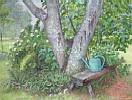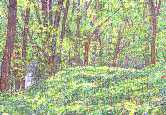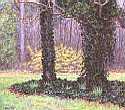Chromatist Paintings
Chromatist Paintings
Click the thumbnails to enlarge the images.
I call my painting style "Chromatism" in order to distinguish it from Impressionism, Post-Impressionism, and Divisionism. I owe a great debt to those nineteenth-century schools, but I have departed from them in significant ways.
"Chromatism" is derived from the Greek word for "color", khroma. Chromatism recognizes that a visual image in the human eye is composed solely of interacting points or areas of color. Like Divisionism, it attempts to create a more powerful image through the careful application of scientific principle. Chromatism, however, takes advantage of the century of neurophysiological discovery which has passed since Seurat.
A visual image is composed of innumerable tiny points of red, blue, and green in varying intensities. The brain takes two of these images, one from each eye, and combines the colors in patterns of secondaries (cyan, magenta, and yellow/brown) and further composites. The tension of two slightly different patterns, interacting and changing constantly, gives us that vivid sense of visual reality which cannot be found in any photographic image.
I cannot reproduce the size, intensity, overlap, or movement of the visual patterns, so I must resort to a collection of careful tricks to imitate the experience of vision. The science of the eye is not enough of a guide: above all, I remain committed to synthesis, compromise, revision, and approximation.
Back to Main Page
Chromatist Paintings
Last Updated October 31st, 2004
Web Page by Ned May
URL http://chromatism.net/chromat.htm
All images and text are ©2017 by Edward S. May unless otherwise noted. All rights reserved.













